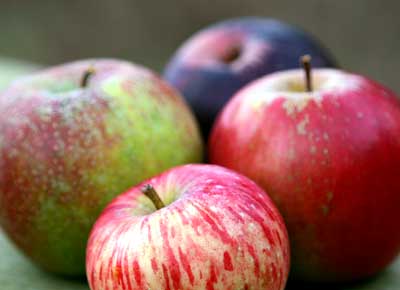
 11
11







 2
2




 5
5




 2
2




Best luck: satisfaction
Greatest curse, greed

 6
6




You don't want a variety of apple; you usually need at least two trees so the bees can pollinate them from each other. I recommend you get trees fruiting at different times, but that may require more trees to ensure pollination.Kristine Erwin wrote:Which variety of apples is the best for homesteading?












 5
5




- Tim's Homestead Journal - Purchase a copy of Building a Better World in Your Backyard - Purchase 6 Decks of Permaculture Cards -
- Purchase 12x Decks of Permaculture Cards - Purchase a copy of the SKIP Book - Purchase 12x copies of Building a Better World in your Backyard
 4
4




 5
5




Kristine Erwin wrote:Which variety of apples is the best for homesteading?
$10.00 is a donation. $1,000 is an investment, $1,000,000 is a purchase.

 1
1




Good point. As a general rule of thumb, the smaller the better.Cécile Stelzer Johnson wrote:. . . try to buy young trees . . .
 3
3




Campbell Ritchie wrote:
Good point. As a general rule of thumb, the smaller the better.Cécile Stelzer Johnson wrote:. . . try to buy young trees . . .
$10.00 is a donation. $1,000 is an investment, $1,000,000 is a purchase.
 3
3




 2
2




Best luck: satisfaction
Greatest curse, greed
 5
5




May God bless you!
Sister Maria Philomena
 2
2




Sister Maria Philomena wrote:I was just given some advice by an expert hard cider maker (went to England to learn the craft). Get some pomace (mash) from a local cider mill (one with an older grinder that leaves the seeds intact), work into about an inch of loose soil (a raised bed works well), put some hay or straw on top, fence it from the deer, and let it go. Come spring, you will get a hundred pips -- those get spread out, are given another year -- and now you have seedlings ready to graft or plant that work with your micro-climate (with no out-of-pocket expense).
$10.00 is a donation. $1,000 is an investment, $1,000,000 is a purchase.
 5
5




Best luck: satisfaction
Greatest curse, greed
 2
2




$10.00 is a donation. $1,000 is an investment, $1,000,000 is a purchase.












 4
4




- Tim's Homestead Journal - Purchase a copy of Building a Better World in Your Backyard - Purchase 6 Decks of Permaculture Cards -
- Purchase 12x Decks of Permaculture Cards - Purchase a copy of the SKIP Book - Purchase 12x copies of Building a Better World in your Backyard
 4
4




Timothy Norton wrote:I've started to consciously try and add one 'fruit' into my daily consumption and have found apples to be a really convenient food.
Looking at nutrition, are there better types of apples than others? Is there much variation?
Best luck: satisfaction
Greatest curse, greed
 3
3




 1
1




With blessings, always
 2
2




$10.00 is a donation. $1,000 is an investment, $1,000,000 is a purchase.
 1
1




JayGee
 2
2




 4
4




 4
4




Jesse Glessner wrote:I'm trying two new projects this year concerning apples.
The first is growing seeds from purchased apples of varieties, Fuji, Gala, Honeycrisp, and Evercrisp. I've had some limited success with all four varieties and will keep those going through to a good transplant size. IF you like good SOLID apples try the Evercrisp (make sure your dentures are well secured!)! :-)
I also am trying to propagate an "apple tree" from the limb of a neighbor's tree that have GREAT apples. I show the wrapped limb below. It is inside a plastic container with fine peat moss, covered with cling wrap and then crinkled tinfoil to keep the birds away. It is in its third-fourth week of a six week process. Hopefully it is forming lots of good roots. I believe this to be a Macintosh, but not sure, nor is the owner aware of the variety.
JayGee

|
A smooth sea never made a skillful sailor. But it did make this tiny ad:
Rocket Mass Heater Resources Wiki
https://permies.com/w/rmh-resources
|








